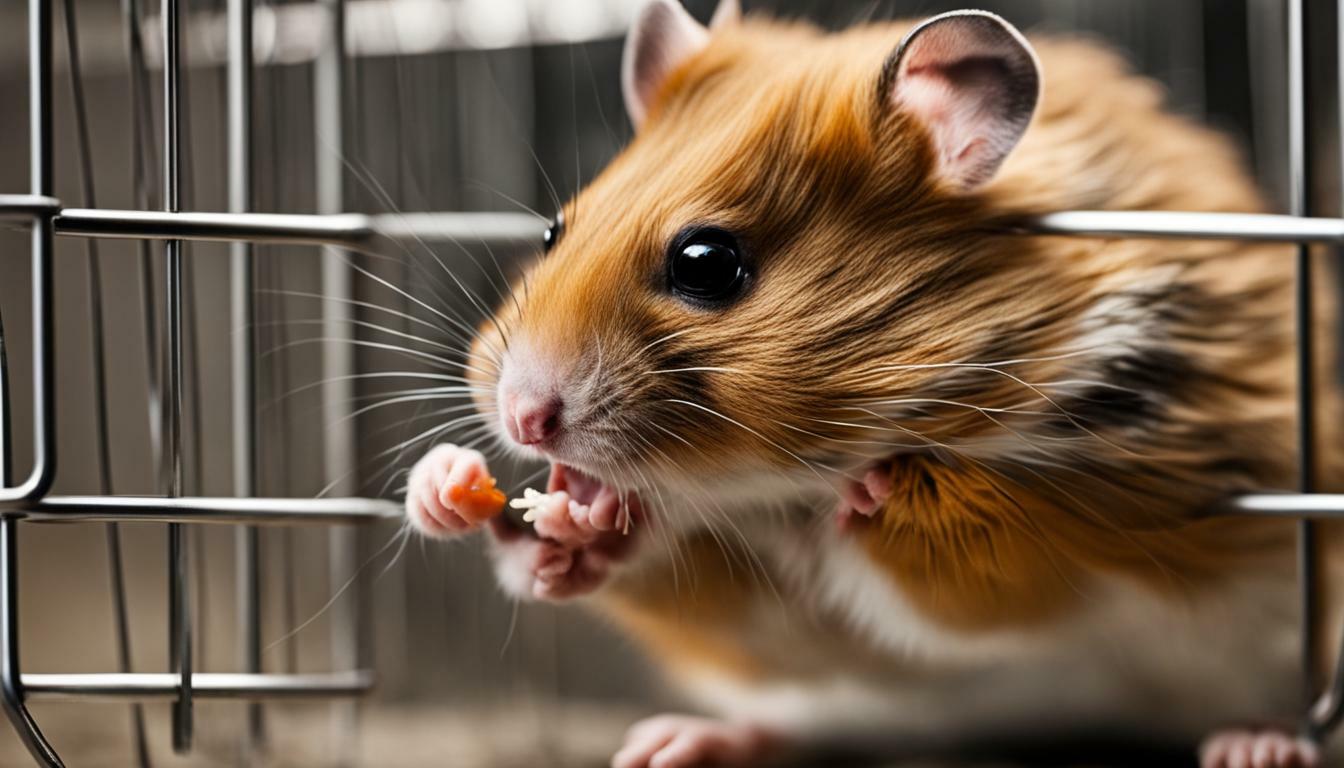Hamsters have a natural instinct to chew on various objects, but can they actually chew through metal? While hamsters possess impressive teeth strength and can gnaw on many materials, chewing on metal bars can be detrimental to their dental health and overall well-being. It’s crucial to understand hamster chewing habits, provide appropriate dental care, and prevent them from damaging their cages.
Key Takeaways:
- Hamsters have a natural instinct to chew on objects to wear down their continuously growing teeth.
- Lack of mental and physical stimulation, boredom, stress, and small cage sizes can contribute to hamsters chewing on metal bars.
- Chewing on metal bars can lead to tooth damage, toxicity from ingesting paint or metal, and the possibility of escape.
- Provide hamsters with suitable chew toys, a spacious cage, and regular playtime to prevent them from chewing on metal bars.
- Consider alternative cage options made of safe materials like glass or suitable alternatives that fulfill their natural behavior.
Understanding Hamster Chewing Habits
Understanding why hamsters love to chew can help you better cater to their needs and prevent damage to their cages. Hamsters have a natural instinct to chew on things, including their cage bars. This behavior is essential for them to wear down their continuously growing teeth. Lack of mental and physical stimulation, boredom, stress, and small cage sizes can contribute to bar chewing behavior.
To prevent your hamster from chewing on metal bars, it is crucial to provide them with appropriate chew toys. These toys help satisfy their chewing needs and divert their attention from the cage bars. Offering a variety of chew toys made of safe materials can keep them engaged and prevent them from damaging their cages.
Common Chew Toys for Hamsters
| Chew Toy | Description |
|---|---|
| Wooden chew sticks | Hamsters love gnawing on wooden sticks, and it helps wear down their teeth naturally. |
| Cardboard tubes | Empty toilet paper or paper towel rolls provide a great chewing option and can also be used for hiding treats. |
| Dried corn husks | These natural chews are safe and enjoyable for hamsters, and they also provide mental stimulation. |
| Mineral chews | Mineral chews made of calcium or other minerals can help keep hamsters’ teeth healthy. |
In addition to providing chew toys, ensuring your hamster has a spacious and suitable cage is essential. A small cage can lead to increased stress and boredom, which may result in bar chewing behavior. Opt for a cage made of glass or a suitable material that doesn’t have metal bars.
Regular playtime outside of the cage is also crucial to keep your hamster mentally and physically stimulated. Setting up a safe play area where they can explore, exercise, and interact with you can help prevent chewing on cage bars.
The Strength of Hamster Teeth
Hamster teeth are surprisingly strong and sharp, allowing them to chew through a range of materials. Their incisors grow continuously, which means they need to constantly chew on objects to keep their teeth worn down and prevent them from overgrowing. This behavior is a natural instinct for hamsters, and it helps maintain their dental health.
However, when it comes to chewing on metal, there are potential risks involved. Metal bars can cause significant damage to a hamster’s teeth, leading to fractures, breakages, or even the loss of teeth. Furthermore, the paint or coating on metal bars may contain toxic substances that can be harmful if ingested. It is crucial to understand these risks and take steps to prevent hamsters from engaging in this behavior.
To protect your hamster’s teeth and prevent cage damage, provide them with appropriate chew toys made of safe materials. These toys should be specifically designed for hamsters, providing a suitable texture and hardness for chewing. Regularly inspect their toys for signs of wear and replace them when necessary.
| Hamster Chew Toys | Material | Benefits |
|---|---|---|
| Wooden chew sticks | Hardwood such as apple or willow | Natural and safe for hamsters to gnaw on, promotes dental health |
| Pumice stone | Volcanic rock | Ideal for wearing down teeth and providing a different texture for chewing |
| Mineral chews | Calcium-rich minerals | Helpful for maintaining strong teeth and preventing mineral deficiencies |
In addition to providing suitable chew toys, ensure your hamster’s cage is spacious and well-equipped with toys, tunnels, and hideaways to keep them mentally and physically stimulated. This can help prevent boredom and the urge to chew on inappropriate objects, such as metal bars. Regular playtime outside of the cage is also essential for their overall well-being.
By understanding the strength of hamster teeth and providing appropriate chew toys and a stimulating environment, you can help prevent hamsters from chewing on metal bars. This will not only safeguard their dental health but also protect against potential cage damage and keep them happy and healthy.
Potential Risks of Chewing on Metal
Chewing on metal can pose several risks to your hamster’s health and safety. While hamsters have a natural instinct to chew, their teeth are not designed to handle hard metal surfaces. The continuous gnawing on metal bars can lead to severe tooth damage and cause pain and discomfort for your furry friend. In addition, the paint or coating on the metal bars may contain toxic substances that can be harmful if ingested.
Furthermore, constantly chewing on metal can indicate underlying issues such as stress or boredom. Hamsters that are not provided with enough mental and physical stimulation in their environment may resort to bar chewing as a way to alleviate their frustration. This behavior can also be a sign that the cage is too small, as hamsters require ample space to explore and engage in normal activities.
Table 1: Risks of Hamsters Chewing on Metal
| Risks | Consequences |
|---|---|
| 1. Tooth Damage | Severe tooth wear or breakage, leading to pain and difficulty eating |
| 2. Toxicity | Ingestion of paint or toxic substances from the metal coating, causing illness or poisoning |
| 3. Stress and Boredom | Indication of a lack of mental and physical stimulation, potentially leading to behavioral problems |
| 4. Escape Risk | Compromised cage structure due to chewing, allowing the hamster to escape |
To protect your hamster from these risks, it is essential to provide a suitable cage that is resistant to chewing. Consider alternative cage materials such as glass or durable plastic that will prevent your hamster from accessing the metal bars. It is also crucial to offer a variety of chew toys specifically designed for hamsters to satisfy their natural chewing instincts and keep their teeth healthy.
In addition to providing an enriched environment and appropriate chew toys, regular playtime and interaction with your hamster can help alleviate stress and boredom. Remember to monitor your hamster’s dental health and seek veterinary care if you notice any signs of tooth damage or discomfort. By taking these preventive measures, you can ensure your hamster’s overall well-being and minimize the risks associated with chewing on metal.
Understanding the Causes of Bar Chewing
Bar chewing in hamsters can be a sign of underlying stress or boredom, indicating the need for environmental enrichment. Hamsters naturally have a strong urge to chew on objects to wear down their continuously growing teeth. However, when this behavior is directed towards metal bars in their cages, it can be harmful to their dental health and overall well-being.
Stress and boredom are common triggers for bar chewing in hamsters. Limited mental and physical stimulation, such as insufficient playtime or lack of interactive toys, can lead to restlessness and frustration. Additionally, small cage sizes can restrict the hamster’s movement and contribute to feelings of confinement, leading to increased bar chewing behavior.
To prevent hamsters from chewing on metal bars, it is crucial to provide them with suitable alternatives and a stimulating environment. Firstly, ensure your hamster has a spacious cage that allows for exploration and exercise. A cage made of glass or a chew-proof material can eliminate the temptation to chew on metal bars.
Additionally, offer a variety of chew toys made specifically for hamsters. These toys promote dental health and provide mental stimulation. Introduce new toys regularly to keep their interest and prevent boredom. By providing appropriate chew toys and a spacious, enriching environment, you can help redirect their chewing behavior away from metal bars, ensuring their dental health and overall happiness.
| Preventing Hamster Cage Damage |
|---|
| Provide a spacious and suitable cage |
| Offer a variety of chew toys |
| Ensure sufficient mental and physical stimulation |
| Regular playtime and interaction |
Preventing Hamsters from Chewing on Metal Bars
With a few preventative measures, you can discourage your hamster from damaging metal objects and keep them safe. Chewing on metal bars can be harmful to their teeth and overall health, so it’s important to provide them with suitable alternatives. Here are some tips to help prevent hamsters from chewing on metal bars:
- Provide appropriate chew toys: Hamsters have a natural instinct to chew, so give them plenty of safe options. Choose chew toys made specifically for hamsters, such as wooden chew sticks or mineral blocks. These will help satisfy their chewing needs and keep their teeth in good condition.
- Ensure a spacious and suitable cage: Lack of mental and physical stimulation, boredom, and small cage sizes can contribute to bar chewing behavior. Make sure your hamster has a spacious cage with plenty of room to run and explore. Include tunnels, exercise wheels, and hiding spots to keep them entertained and prevent boredom.
- Regular playtime: Hamsters need daily interaction and playtime to stay mentally stimulated. Set aside some time each day to interact with your hamster outside of their cage. Use safe play areas where they can explore and play without the temptation of chewing on metal objects.
Hamster-Chewing Deterrent:
If your hamster continues to chew on metal objects, you can try using a hamster-chewing deterrent. These are available in pet stores and are designed to discourage chewing behavior. Apply the deterrent onto the metal surfaces that your hamster is targeting, following the product instructions carefully. The taste or smell of the deterrent will deter them from chewing on the metal bars.
| Prevention Measures | Benefits |
|---|---|
| Providing appropriate chew toys | Keeps their teeth healthy and satisfied |
| Ensuring a spacious and suitable cage | Prevents boredom and stress-related behaviors |
| Regular playtime | Provides mental stimulation and interaction |
By following these preventative measures, you can discourage your hamster from damaging metal objects and promote their well-being. Remember to monitor your hamster’s behavior and consult with a veterinarian if you have any concerns about their chewing habits or dental health.
How to Protect Metal from Hamster Chewing
Protecting metal objects from your hamster’s chewing can help preserve them and keep your furry friend safe. Hamsters have a natural instinct to chew on things, including cage bars, but chewing on metal can be harmful to their teeth and overall health. It is important to take measures to prevent them from chewing on these potentially dangerous objects.
One way to protect metal objects is by providing your hamster with appropriate chew toys. These toys are designed to satisfy their need to chew and help keep their teeth worn down. Choose toys made of safe and durable materials, such as untreated wood or hard plastic, that are specifically designed for hamsters. By redirecting their chewing behavior to these toys, they are less likely to target metal objects.
Another effective method is hamster-proofing metal objects in their environment. Covering metal surfaces with non-toxic materials, such as plastic or tape, can create a barrier between the metal and your hamster’s teeth. This prevents them from causing damage to their teeth or ingesting harmful substances. Additionally, providing alternative objects for them to chew on, such as mineral chews or hay, can help divert their attention away from metal objects.
| Tips to Protect Metal from Hamster Chewing |
|---|
| Provide appropriate chew toys made of safe and durable materials. |
| Hamster-proof metal surfaces by covering them with non-toxic materials. |
| Offer alternative chewing options, such as mineral chews or hay. |
Remember, hamsters chew on objects not only to maintain their teeth but also as a form of mental and physical stimulation. Ensuring they have a spacious and suitable cage, with plenty of toys and activities, can help prevent boredom and stress-induced chewing behaviors. Regular playtime outside the cage, under supervision, can also provide additional mental and physical stimulation for your hamster.
Safe Alternatives to Metal Cages
If you’re concerned about your hamster’s chewing behavior, consider alternative cage materials that are resistant to their teeth. Hamsters have a natural instinct to chew, and metal cage bars can be easily damaged by their strong teeth. Switching to a cage made of glass or a suitable material can help prevent hamster cage damage and ensure their safety.
One safe and durable option is a glass enclosure. Glass cages not only provide a clear view of your hamster but also prevent them from chewing through the walls. Glass is resistant to their teeth and provides a secure environment while allowing your hamster to exhibit their natural behaviors.
Another alternative is using a cage made of a chew-resistant material such as thick plastic or high-density polyethylene (HDPE). These materials are tough enough to withstand hamster chewing and can offer a long-lasting solution to prevent cage damage. Look for cages specifically designed to be chew-proof or with reinforced corners and walls that can withstand the constant nibbling.
When choosing a cage, consider its size and design. The enclosure should be spacious enough to accommodate your hamster’s needs and provide room for exercise and exploration. Additionally, provide a variety of chew toys to divert their attention away from the cage bars. Chew toys made of safe materials such as wood, sisal, or other hamster-safe materials can help satisfy their chewing instincts and keep their teeth healthy.
| Advantages of Safe Alternatives to Metal Cages | Disadvantages of Safe Alternatives to Metal Cages |
|---|---|
|
|
Ensuring Hamster Dental Health
Taking care of your hamster’s dental health is crucial in preventing dental problems caused by excessive chewing. Hamsters have continuously growing teeth, and they rely on chewing to wear them down. Lack of proper dental care can lead to tooth overgrowth, pain, and potential complications that can affect their overall well-being.
One way to ensure your hamster’s dental health is by providing appropriate chew toys. These toys not only satisfy their natural instinct to chew but also help keep their teeth in good condition. Choose toys that are safe and specifically designed for hamsters, such as wooden chew sticks or mineral chews. Avoid giving them objects made of hard plastic or metal, as these can cause tooth damage.
Another important aspect of hamster dental care is providing a spacious and suitable cage. A cramped or overcrowded cage can contribute to stress and boredom, leading to excessive chewing, including on metal bars. Ensure that the cage size is appropriate for your hamster’s breed and provides enough room for them to move around and engage in natural behaviors.
| Tip: | Choose a cage made of glass or a suitable material that is safe and prevents the hamster from chewing on metal bars. This not only eliminates the risk of dental problems but also ensures their safety by reducing the chance of escape. |
|---|
Lastly, regular playtime and interaction with your hamster are essential for their mental and physical stimulation. Spending quality time with your furry friend outside the cage allows them to explore, exercise, and satisfy their natural instincts. This helps reduce boredom and the need for excessive chewing, including on metal bars.
By taking these steps to ensure your hamster’s dental health, you can prevent dental problems, promote overall well-being, and provide them with a happy and enriching environment to thrive in.
Conclusion
By understanding hamster chewing habits and implementing preventative measures, you can protect your hamster and maintain their dental health. Hamsters have a natural instinct to chew on things, including the bars of their cages. However, chewing on metal bars can be harmful to their teeth and overall well-being. Their teeth continuously grow, and chewing helps keep them worn down. Lack of mental and physical stimulation, boredom, stress, and small cage sizes can contribute to bar chewing behavior.
To prevent your hamster from chewing on metal bars, it is essential to provide them with appropriate chew toys. These toys will not only satisfy their chewing instincts but also keep their teeth healthy. Additionally, make sure to provide a spacious and suitable cage for your hamster, allowing them enough room to move around and engage in natural behaviors. Regular playtime outside the cage is also crucial for their mental and physical stimulation.
Chewing on metal bars can lead to various issues, including tooth damage, toxicity from ingesting paint or metal, and potential escape if the cage becomes compromised. To avoid these risks, consider choosing a safe cage made of materials like glass or other suitable alternatives that are durable and escape-proof. Furthermore, always provide a variety of chew toys that are safe for your hamster to gnaw on, satisfying their need to chew while keeping their teeth healthy and preventing them from resorting to metal bars.
Remember, your hamster’s dental health is vital for their overall well-being, so it is essential to provide proper care and attention. Regular veterinary check-ups, a balanced diet, and suitable chew toys will help ensure that their teeth stay in good condition. By following these preventative measures and providing a stimulating environment, you can keep your furry friend happy, healthy, and free from the dangers of chewing on metal bars.
FAQ
Can hamsters chew through metal?
Yes, hamsters have a natural instinct to chew on things, including cage bars. However, chewing on metal bars can be harmful to their teeth and overall health.
Why do hamsters chew on bars?
Hamsters’ teeth continuously grow, so they need to chew on objects to keep them worn down. Lack of mental and physical stimulation, boredom, stress, and small cage sizes can contribute to bar chewing behavior.
What are the risks of chewing on metal bars?
Chewing on bars can lead to tooth damage, toxicity from ingesting paint or metal, indicate stress or boredom, and potentially lead to escape.
How can I prevent my hamster from chewing on metal bars?
Providing hamsters with appropriate chew toys, a spacious and suitable cage, and regular playtime can help prevent them from chewing on metal bars.
How can I protect metal objects from hamster chewing?
You can use protective coatings, cover metal surfaces, and provide appropriate chew toys as alternatives to satisfy their chewing needs.
What are safe alternatives to metal cages?
Glass or suitable material cages are safe alternatives to prevent hamsters from chewing on metal bars.
How can I ensure my hamster’s dental health?
Proper nutrition, regular veterinary check-ups, and providing appropriate chew toys are essential for maintaining your hamster’s dental health.




